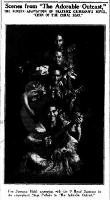AustLit
 7033926785135101841.jpg
7033926785135101841.jpg
Promotional image, Townsville Daily Bulletin, 3 August 1928, p.11 (via Trove Australia)
Alternative title:
Black Cargoes of the South Seas
Adaptation of
Conn of the Coral Seas
1922
single work
novel
Issue Details:
First known date:
1928...
1928
The Adorable Outcast
The material on this page is available to AustLit subscribers. If you are a subscriber or are from a subscribing organisation, please log in to gain full access. To explore options for subscribing to this unique teaching, research, and publishing resource for Australian culture and storytelling, please contact us or find out more.
Film Details - Australasian Films , 1928
Producers:
Norman Dawn
Production Companies:
Australasian Films
Director of Photography:
Arthur Higgins
William Trerise
Editors:
Mona Donaldson
Production Designers:
James Coleman
Cast:
Incl. Edith Roberts (Luya), Edmund Burns (Stephen Conn), Walter Long (Fursey), Jessica Harcourt (Diedre Rose), Jack Gavin (Carberry), Katherine Dawn .(Elizabeth), Arthur McLaglen (Iron Devil), Arthur Tauchert (Mack), Fred Twitcham (Sir John Blackberry), Compton Coutts (Pooch), William O'Hanlon (Pearler 1), Claude Turton (Pearler 2), Charles Weatherby, Tom Dalton, Walter Hunt.
Release Dates:
25 June 1928 (Tivoli Theatre, Brisbane - premiere). The film was given limited release in the USA in 1929 under the title Black Cargoes of the South Seas.
Location:
- Filmed on location in Fiji. Interior scenes were shot at Australasian Films Bondi studios.
Notes:
1. This was the final feature film for Australasian Films. The high cost of this production (£35,000), on top of the £50,000 pounds spent on For the Term of His Natural Life (q.v.), and compounded by the uncertainty surrounding the new sound film, was more than the company could justify. Without a guaranteed commitment from overseas distributors, the company focused instead on its heavy commitments in theatre construction.
2. Further reference: Andrew Pike and Ross Cooper. Australian Film 1900-1977, A Guide to Feature Film Production (1980, q.v.), p. 189.
Settings:
- South Pacific, Pacific Region,


